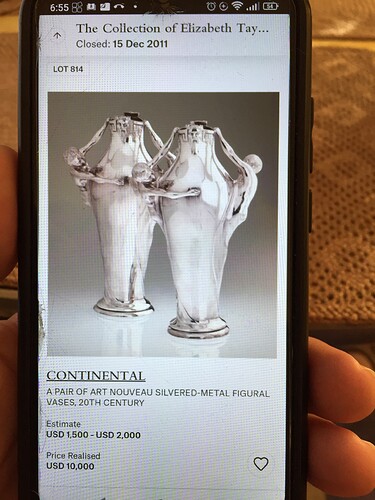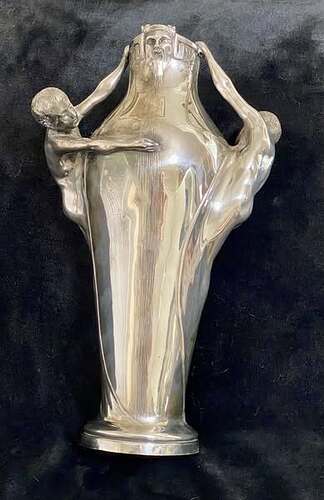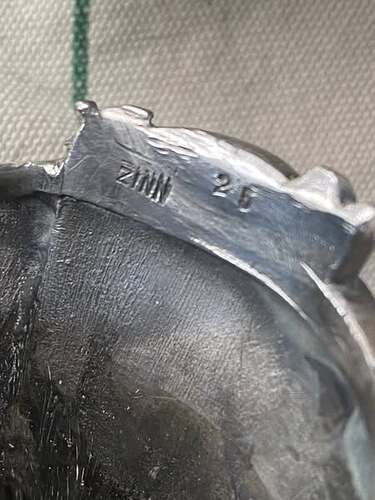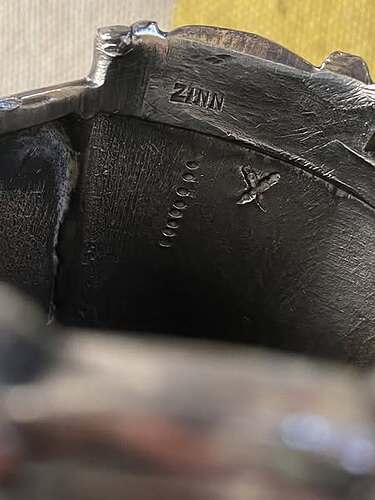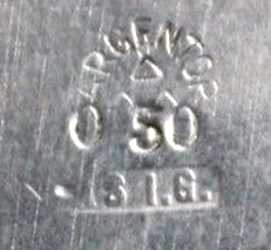Hi there. First post. Can anyone identify this? Age, value etc. I believe it was Zinn, Mariahilfestrasse, Vienna. Only cos my mum is from Vienna and used to walk by their store on her way to work each day and said she’d seen similar items - long time ago, she’s 90 now. Anyhooo, I bought this at a yard sale in San Angelo Texas. Only other thing I know, per photo, is that the late Elizabeth Taylor had a matching pair which were sold at her charity auction.
Any chance of some pics of your yard sale find and any marks or hallmarks it may have ?. Thank you ![]()
“Zinn” is German for “tin” which is a key ingredient in Pewter. So this may well be a pewter duplicate of an often copied vase.
I have found numerous examples of this item for sale as " White Metal".
Exactly what “silvered metal” in the Taylor auction catalog example means I am not sure. Might mean electro-plated, or it might refer to Britannia or white metal which again is 93% tin mixed with antimony and copper. It is used for making various household items and known for its smooth surface.
So value? Well apparently if Ms Taylor can be found guilty of once owning it, then $10,000.00 but realistically? Bonhams sold one for an ask of $1,600.00 a few years ago and the scrap value of tin is $1.50 a pound so somewhere between those two numbers.
Mariahilfer Straße is the largest and one of the most famous shopping streets in Vienna so this vase was perhaps sold out of a store your Mother visited or walked by. But it likely wasn’t called “Zinn”.
“Zinn Pan Alley”? Tin Pan Alley is more the title of a song than a place. If it were a place it would be in lower Manhattan
CRWW
But only with absolutely ironclad provenance. All too often, these ownership myths are little more than family lore. “This sterling mirror was owned by Marie Antoinette!!” But with a hallmark for Sheffield, 1883, perhaps not… ![]()
It’s also interesting to speculate about why an inanimate object acquires a much higher value, based solely upon who might have touched it a century ago. But it happens all the time.
This I think might be the store front on Mariahilfer Straße.
The factory where this vase may have been made by Argentor-Werke Rust & Hetzel was established in Vienna in 1902. in Vienna is still extant. It is now apartments.
Here’s another similar vase. This one is marked for Argentor. Your picture does not show a similar mark.
Thank you so much.
I like my vase-thingy. I paid US$150. It’s very elegant and I like that it’s from Austria given my maternal lineage.
Thank you for your help.
Juliana
Well, I just had to bring it out of the cabinet . It’s super hard to see but on the bottom rim, it is marked Argentor in tiny letters. So small I can’t photograph it but I can read it through a magnifying glass. Inside it says Zinn 25 so I’m wondering if it was made in 1925. Which would make it 100 years old - which I think makes it a true antique.
It’s a great vase. Britannia Metal unless you are going to tell us it is plated. Art Nouveau, Probably rather older than 1925 and worth rather more than you paid for it. I suspect the 25 is a product number rather than a year.
The Argentor factory, known for Art Nouveau, produced a variety of decorative and functional objects, including cutlery, bowls, centrepieces, and clock cases, often incorporating designs from artists associated with the Wiener Werkstätte group, founded by Josef Hoffmann, Koloman Moser, and Fritz Waerndorfer.
That artists’ and craftsmen’s collective existed in Vienna from 1903 until 1932, very much the same dates as the factory.'s most important period. The collective’s stated goal was to bring high-quality design and craft into fairly mundane articles of life.
During that time, the collective produced in a variety of media including ceramics, furniture, glass, jewelry, metalwork, and textiles. Their style influenced generations of architects from Bauhaus to Art Deco and especially Art Nouveau.
Wiener Werkstätte members such as Josef Hoffmann, Koloman Moser, and Dagobert Peche along with lesser known designers such as Gudrun Baudisch, Carl Otto Czeschka, and Ugo Zovetti who were also part of the collective.
There is a useful reference: “Wiener Werkstätte, 1903-1932: The Luxury of Beauty” which includes in-depth essays that explore the Wiener Werrkstätte’s long history and legacy if you want more on them. Amazon will sell you a copy or your local library may have it on shelves.
CRWW
Agreed - at first glance, I thought, “1905.” It’s certainly not Art Deco! ![]()
Yes, but what we still don’t know is who the designer was and what it reps. There are elements of the French artist Henri Matisse’s *Dance" in it, but this work is designed to calm. Matisse wanted and got a much more visceral reaction.
Hopefully someone with knowledge of the pre-war period will spot this floundering around and put us on on the right track. I can well see why someone paid Ms. Taylor’s estate for what may not even be another copy. of it.
CRWW
Well - I guess I’ve learnt that taking photos is best done in daylight through a magnifying glass (as opposed to at night when I’m tired). This is stamped on the bottom rim - very tiny and perhaps slightly worn away. Grateful to everyone on here with advice. It’s super nice to learn about this from knowledgeable people.
In the photograph of Argentor-Werke store on Mariahilfestrasse, third shelf down, right hand side, 6th item from left to right - looks suspiciously like mine.
The one on first dibs has a different bottom rim and looks to have been manufactured (or altered) to allow for lamp wiring.
You are now officially an expert photographer, Silver is deuced difficult to capture by photograph.
The modern standard Apple pixel count still isn’t high enough. There are two digital phone cameras made by the competition which are multiple times better, but its like UK radar defence in WWII, good enough was good enough given the time. (And in that case worked well as the Germans couldn’t figure out why such a degraded signal compared to their was emanating at all concluding there was no radar to worry about, so left the mast intact Which is probably why we are conducting this conversation in English rather than German.
CRWW
